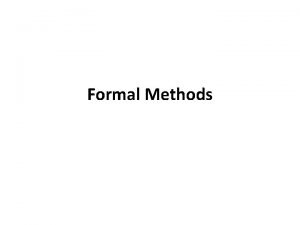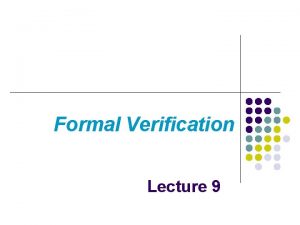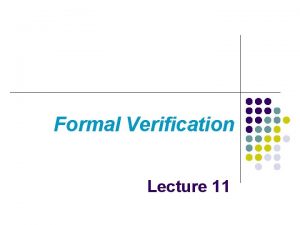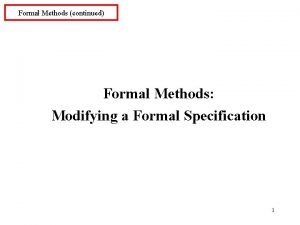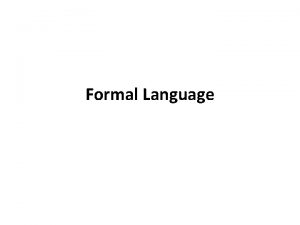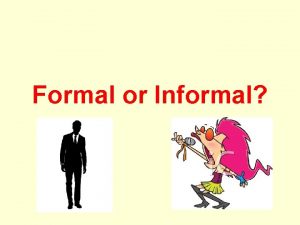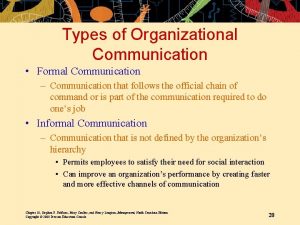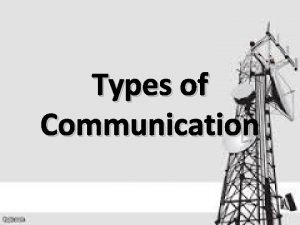Types of Communication Formal Communication The communication in












- Slides: 12

Types of Communication

Formal Communication The communication in which certain norms, rules and regulations are followed is known as Formal Communication. Formal communication may follow any direction-Vertical, horizontal, diagonal. It is always well planned. It is restricted to certain limit of time and hence it is time bound. In Formal communication conversation cannot exceed beyond a stipulated time. Usage of slang (very informal words), jargon (words or expressions that are used by a particular profession or group of people) and colloquial[(of words and language) used in conversation but not in formal speech or writing] not permitted. Thus formal communication is time bound, topic bound and language bound. It is hierarchical in nature. e. g. Meetings, seminars, conferences, lectures, speeches, orals, interviews, theory exams, practical exams, teamwork etc.

Informal Communication (Grapevine communication) � � � Any unofficial communication is called as Informal Communication. It is also termed as Grapevine Communication. It may be internal or external in it’s application for the organisation. Informal discussion, general comments that passed from one person to another person are the examples of Informal communication. e. g. Gossips(disapproving), informal talk or stories about other people’s private lives, hearsay, rumours, informal chat among peers, colleagues, friends and groups are the examples of the grapevine communication. It usually occcurs among friends, relatives and family members. It is structureless, unofficial and unplanned communication. It spreads like wildfire. Informal communication takes place during lunch break, tea break, get together, short recess, off periods or free periods, seminars, meetings etc.

Verbal Communication � � � The communication with the help of words is called as Verbal Communication. Any form of communication where words are used to convey a message is known as Verbal Communication. It has two forms namely Oral and Written. Oral Communication: -Everything that is spoken(oral), falls in this category. In oral communication, the sender and the receiver, both exchange their ideas or facts through spoken(oral) words either in face-to-face conversation or through any mechanical/electrical device. E. g. Telephone e. g. Radio broadcast, interviews, oral exams, group discussions, meetings, seminars, conferences, public addresses, speeches, prayer, meetings etc. Written Communication: - Everything that is written and transmitted in the written form falls in the area of written communication. In other words everything i. e. in printed form or black and white is known as written communication. It includes letters, notices, circulars, memos, telegrams, reports, notes, minutes, questionairies, handbooks. It is accurate and precise. It is authentic. It is a legal document. It is permanent. It is suitable for lengthy messages. It is very useful in official transactions.

Nonverbal Communication � When communication between two or more persons takes place without making use of words either written or oral is called as Nonverbal Communication. In other words the communication with the help of wordless messages is called as Nonverbal Communication. It includes two types. � A. Body Language B. Graphic Language/Visual Language

Body Language � It is very effective form of nonverbal communication. Body language includes gestures, posture, facial expressions, eye contact, pause, dress code, touch, silence etc. � Body language helps the sender to convince the receiver. Similarly, it helps the receiver to understand more perfectly. The oral communication if accompanied by proper body language, brings fruitful results.

Graphic Language/Visual Language � Graphic i. e. visual communication makes a noticeable impact on the audience (receiver). Graphic language includes maps, posters, charts, colours, or signs, symbols, graphs, tables, pictograms etc. � It is easy to understand. It is brief and precise. It is easy to remember. It gives information at glance. It is an effective means of communication. It is free from barriers. It is very useful and suitable for technical and engineering fields.

Vertical Communication � In any organisational set up, vertical communication is between employees and employers. Communication between the people working on the upper and lower levels in the organisation is called as Vertical Communication. It has two types. They are as follows. � a. Upward Communication. � b. Downward Communication.

Upward Communication � The communication that flows from subordinate to superiors (i. e. Junior to Senior) is called as Upward Communication. Reports Suggestions Grievances Complaints Proposals Requests The workers get an opportunity to participate in the organisation. It helps the management in decision making.

Downward Communication � The communication that flows from the superior to the subordinate (i. e. from senior to junior) is known as Downward Communication. It is regulated by formal procedures and practices in the organisations. Orders Instructions Directives Procedures Lectures Policies Counseling Award It is useful to initiate, influence and control the activities at the subordinates. It gives a greater job satisfaction and improves the morale of the employees.

Horizontal Communication � � It refers to the communication among people working at the same level of authority. In other words, it is the communication between persons of same hierarchical level. e. g. Meetings of Principals of different institutes. Inter-department Memos Inter-personal Dialogues Telephonic Conversations Union-Management Meetings � It helps in co-ordinating the activities of the different departments. It is fast and flexible. There is no scope for rumours or gossips. It helps in taking quick decisions.

Diagonal Communication (Cross-wise Communication) � This informal communication is also known as Cross-wise Communication, as it does not follow any chain of command. It spreads in any direction. It does not follow any set pattern. � A person working at a higher level of authority in his organisation may be required to correspond with a person working at a lower level or viceversa; this is called as Diagonal Communication. � E. g. The principal of polytechnic college can directly communicate with any student. Similarly, the student can also communicate with the principal for making enquiry or submitting of any confidential information.
 Cross wise communication
Cross wise communication Hát kết hợp bộ gõ cơ thể
Hát kết hợp bộ gõ cơ thể Lp html
Lp html Bổ thể
Bổ thể Tỉ lệ cơ thể trẻ em
Tỉ lệ cơ thể trẻ em Voi kéo gỗ như thế nào
Voi kéo gỗ như thế nào Tư thế worm breton
Tư thế worm breton Bài hát chúa yêu trần thế alleluia
Bài hát chúa yêu trần thế alleluia Môn thể thao bắt đầu bằng chữ đua
Môn thể thao bắt đầu bằng chữ đua Thế nào là hệ số cao nhất
Thế nào là hệ số cao nhất Các châu lục và đại dương trên thế giới
Các châu lục và đại dương trên thế giới Công thức tính thế năng
Công thức tính thế năng Trời xanh đây là của chúng ta thể thơ
Trời xanh đây là của chúng ta thể thơ













